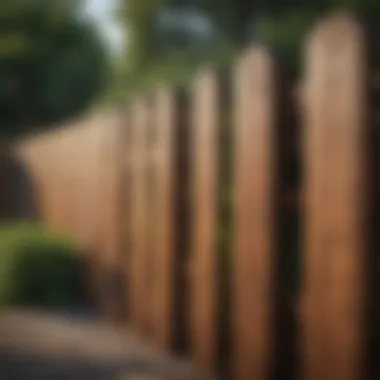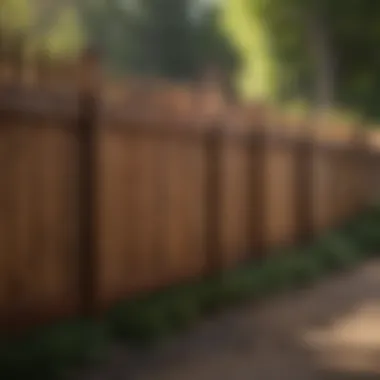Cost Analysis of Installing a 200 Sq Ft Fence


Intro
Installing a fence can significantly enhance the security and aesthetic appeal of a property. With a 200 square foot area, homeowners can choose from a variety of options that fit their needs and budgets. However, the costs associated with such an installation are multifaceted and require careful consideration.
This guide aims to delve into the various factors influencing the expenses of a fence installation. The analysis will touch on the selection of materials, the complexity of labor, and regional price variances, among other elements. Homeowners and DIY enthusiasts alike will benefit from understanding permit requirements and maintenance considerations associated with fencing projects.
Preamble to Fence Installation Costs
Fencing is an essential component in many residential landscapes. It serves various purposes, from providing security to enhancing curb appeal. Understanding the cost associated with fence installation is crucial for homeowners planning to build or upgrade. Various elements influence these costs, making it necessary to evaluate them thoroughly.
Understanding the Importance of Fencing
Fencing holds significant importance for several reasons. It delineates property boundaries, ensuring clear demarcation between personal space and public areas. Furthermore, depending on the material, it offers varying levels of privacy and security. For families with children or pets, a well-constructed fence provides a safe environment, preventing accidental escapes or intrusions. Additionally, aesthetically pleasing fences contribute positively to the overall look of a home, potentially increasing property value. Thus, investing in a fence is not merely a functional necessity; it is also a strategic decision in real estate.
Scope of the Article
This article examines a comprehensive cost analysis for installing a 200 square foot fence. It covers various factors influencing pricing, including material selection, labor costs, and geographical location. Readers will find detailed information about different types of fencing materials, the average costs associated with each, and considerations for permits that may be required based on local regulations. By the end of this exploration, homeowners will gain valuable insights into budgeting for their fencing projects. This knowledge is imperative for making informed decisions and avoiding unexpected expenses.
"Being aware of the costs involved in installing a fence can significantly aid in decision-making, ensuring that your project stays within budget."
Understanding the intricacies of fence installation costs can empower homeowners and DIY enthusiasts alike to plan efficiently and wisely.
Factors Influencing Fencing Costs
Fencing installation involves multiple financial variables that can significantly affect the total cost. Understanding these factors is essential for homeowners planning a new fence. Proper assessment of every component helps avoid unexpected expenses and ensures that investments align with desired outcomes.
Material Selection
Wood
Wooden fences are a classic choice for many properties. They provide natural aesthetic appeal, offering warmth and versatility in design. Highly valued for their ability to blend with various landscapes, wooden fences come in different styles such as picket, privacy, and rail fences. Moreover, one significant characteristic of wood is its availability. Different types like cedar, pine, or redwood vary in cost.
However, wood demands regular maintenance due to susceptibility to weathering, pests, or rot. Over time, it may necessitate painting or staining, which adds to long-term costs but can enhance durability.
Vinyl
Vinyl fences have gained popularity for their durability and low maintenance requirements. They resist fading and cracking better than wooden options. A key characteristic of vinyl is its wide range of colors and styles available, allowing personalization without painting. The initial investment might be higher than wood, but it pays off in lower upkeep costs over time.
A unique feature of vinyl is its recyclability. This makes it an environmentally friendly choice. However, homeowners should consider that repairing a damaged vinyl section might be more complicated than wood.
Chain Link
Chain link fencing is often regarded as the most affordable option. Its primary benefit lies in its cost-effectiveness and ease of installation. It provides a practical solution for keeping pets safe or marking property boundaries. The main characteristic is its visibility, which might not provide the privacy some homeowners seek.
This fencing type is robust and requires little maintenance, making it a suitable choice for budget-restricted projects. However, its lack of aesthetic appeal might deter some homeowners, and the wire can be prone to rust over time if not coated properly.
Wrought Iron
Wrought iron offers a distinctive elegance and high durability. Its strength makes it an excellent option for security conscious homeowners. A notable characteristic is its capability to be shaped into various artistic designs, enhancing curb appeal.
However, wrought iron does come with a steeper price tag compared to other materials. Regular maintenance is necessary to prevent rust, particularly in damp environments. Furthermore, installation can require specific skills, potentially increasing labor costs.
Composite
Composite fencing blends wood materials with plastic polymers. This combination results in a material that shares the aesthetic appeal of wood but with improved durability. This type is low-maintenance and resistant to color fading, insects, and rot.
One unique feature of composite is its sustainability; it often utilizes recycled materials. Because of these advantages, composite fences are increasingly popular, although they usually come at a higher up-front cost.
Labor Costs
Average Labor Rates


Labor rates can significantly sway the final cost of a fencing project. Skilled labor is typically compensated at higher rates than general labor. Factors affecting these rates include local demand for labor and expertise required for the specific type of fence. Knowing average rates in the area can aid homeowners in estimating total costs more accurately.
A unique feature of labor costs is the potential for fluctuations. Busy seasons may lead to increased prices and should be planned for if one desires to keep costs within budget.
Complexity of Installation
The complexity of the chosen fencing style directly influences the labor costs. More intricate designs like wrought iron or curved fences need skilled professionals, raising the overall expense. Simpler styles, such as a chain link fence, might reduce labor time and costs. Understanding the complexities involved, helps homeowners make informed choices aligning with their budgets.
Another notable aspect is that unforeseen challenges, such as rocky soil or difficult terrain, can compound installation difficulties, leading to additional labor needed and costs incurred.
DIY vs Professional Help
Choosing between a DIY project versus hiring professionals can be a significant decision. For some, DIY offers a chance to save on labor costs while also tailoring the fence installation more personally. However, it requires not just time but a level of skill.
On the other hand, professional help ensures quality installation and adherence to local regulations. Hiring professionals can save time and provide peace of mind, but at an increased financial cost. Balancing personal capabilities with the necessity for quality should guide this decision effectively.
Geographical Variations
Cost Variances by Region
The geographical location heavily influences fencing costs. Urban areas may incur higher labor and material prices due to demand. In contrast, rural regions might offer lower costs, allowing for budget-efficient solutions. Understanding local market trends provides insight into these variances.
A unique feature to remember is the addition of logistics costs. Transporting materials to remote areas can increase overall expenses, affecting project budgets.
Local Market Influences
Local market influences, including supply and demand, affect fencing projects as well. Availability of materials can vary, causing price shifts. Moreover, varying local regulations can impact the total costs relating to installation or permits needed.
Monitoring neighborhood trends and community requirements can ensure more accurate budgeting, helping homeowners navigate pricing effectively.
Estimating Costs for a Sq Ft Fence
Estimating the costs for a 200 square foot fence is a crucial step in any fencing project. A well-prepared cost estimate provides clarity and can prevent unexpected financial surprises down the road. Homeowners and DIY enthusiasts must consider various elements such as material, labor, and potential additional expenses. This section addresses specific cost factors and provides a structured approach to budgeting, ensuring that you can manage your fencing project effectively.
General Pricing Guidelines
When planning for a fence, it is important to have general pricing guidelines in mind. Here are several considerations to keep in mind that will help guide your budgeting process:
- Material Type: The type of fencing material selected greatly influences overall costs. Each material comes with unique price points. For example, wooden fences often have lower initial costs but require ongoing maintenance, while vinyl fences might be higher upfront but have lower long-term costs.
- Length of Fence: The overall length of the fence affects the total material needed and therefore the total cost. A standard estimation involves considering both the perimeter and design specifics of your intended area.
- Installation Complexity: The complexity of the installation process can result in higher labor costs. Factors include terrain, proximity to utilities, and existing structures. A clear understanding of these factors aids in accurate cost estimation.
Comparative Cost Analysis by Material
A comparative cost analysis by material offers valuable insights into the various fencing options available. Each material has distinct characteristics that affect cost and suitability.
Cost of Wooden Fences
Wooden fences are a popular choice among homeowners due to their natural aesthetic appeal. The costs for wooden fences typically range depending on the type of wood chosen. Pine is generally more affordable, while cedar and redwood are associated with higher costs due to their durability and resistance to decay.
Despite their initial affordability, wooden fences may necessitate regular maintenance. This includes staining, sealing, and repairs due to rot or insect damage. Overall, wooden fences provide a warm look but require careful budget consideration for ongoing upkeep.
Cost of Vinyl Fences
Vinyl fences come with their unique advantages and disadvantages. They tend to have a higher upfront cost compared to wooden options. However, vinyl fences are known for their low maintenance requirements. They do not require painting or staining, thus saving time and money in the long run.
Additionally, vinyl fences are available in a variety of colors and styles, which adds to their appeal. The primary disadvantage is their higher initial investment, which might be a concerning factor for budget-conscious homeowners.
Cost of Wrought Iron Fences
Wrought iron fences are recognized for their durability and ornamental appeal. The cost of wrought iron is typically on the higher end of the spectrum due to their strength and longevity. They also provide a high level of security while maintaining an elegant look.
However, they can be prone to rust, necessitating occasional maintenance and rust-proofing treatments. Therefore, the total cost over the fence's lifespan should be thoroughly evaluated.
Cost of Chain Link Fences


Chain link fences represent one of the most economical options available. They are cost-effective and relatively easy to install. The overall cost is usually lower compared to other materials, making them an ideal choice for those on a tight budget.
While they excel in durability, they do provide less privacy and aesthetic appeal. Homeowners looking for functionality without significant visual barriers might find chain link fences sufficient for their needs.
Cost of Composite Fences
Composite fences are becoming increasingly popular due to their combination of wood and plastic materials. They offer the aesthetic qualities of a wooden fence while resisting decay and requiring minimal upkeep. The upfront cost of composite fencing may be somewhat higher than wood but is offset by long-term savings on maintenance.
Their unique feature is the lack of splitting or warping seen in traditional wood. The decision to invest in composite fencing hinges on personal preferences regarding sustainability and durability versus initial investment.
In summary, understanding the detailed cost structure associated with each material allows homeowners to make informed choices for their fencing needs.
Additional Costs to Consider
When planning a fence installation, it’s vital to go beyond just the initial material and labor expenses. Additional costs can significantly impact the overall budget and should be factored into the overall cost analysis. These expenses include permits, maintenance, and other unforeseen expenses that may arise during or after installation. Addressing these factors helps ensure that homeowners start their projects with a realistic understanding of total expenses.
Permits and Regulations
Understanding Permit Requirements
Before commencing any fence installation, understanding the permit requirements is crucial. Many local jurisdictions necessitate permits for fence construction, which serve to uphold community standards and safety regulations. These permits can require specific designs or heights, which can impact how a homeowner plans their project. Not acquiring the proper permits may result in fines or the need to remove or alter the installed fence, creating a further financial burden.
The key characteristic of permit requirements is that they vary significantly by location. Some cities have strict guidelines, while others are more lenient. This variability makes it beneficial for residents to consult with local authorities prior to planning their fencing project. Additionally, taking the time to understand these requirements can prevent costly errors later on.
- Advantages: Complying with local regulations ensures a smoother installation process.
- Disadvantages: Navigating the permitting process can be challenging and add time to the project.
Cost Implications of Permits
The cost implications of permits can vary widely depending on local laws and requirements. Generally, permit fees are a small fraction of the overall project but can add up if multiple permits are needed. For example, some homeowners may need permits for installation in different zoning areas or for specialized materials, further inflating the total budget.
Being aware of these costs allows homeowners to incorporate them into their overall budget effectively. Understanding the range of permit fees in a given area can also help in choosing designs or materials that may avoid costly fees altogether.
- Advantages: Planning for permit costs in advance helps in setting a realistic budget.
- Disadvantages: Failure to account for these costs may lead to budget overruns.
Maintenance Costs
Expected Lifespan of Different Fence Types
The expected lifespan of different fence types varies greatly and plays an important role in the long-term cost analysis of a fence installation. For instance, wooden fences typically last between 5 to 15 years, depending on maintenance. In contrast, vinyl and wrought iron fences can last significantly longer, sometimes exceeding 25 years. This differentiation is essential for homeowners who wish to invest in durable solutions.
Knowing the lifespan helps in estimating replacement costs down the line, allowing for better budgeting. Choosing a longer-lasting material may be more cost-effective in the long run, despite higher upfront costs.
- Advantages: Selecting durable materials can reduce the need for frequent repairs or replacements.
- Disadvantages: Higher initial costs may deter some homeowners from opting for superior materials.
Annual Maintenance Expenses
Annual maintenance expenses are another critical factor to consider while budgeting for a fence installation. Different materials require varying levels of upkeep. For example, wooden fences may need regular sealing or painting, whereas vinyl requires minimal maintenance. Over time, these costs can accumulate, affecting the overall financial commitment to maintaining the fence.
Understanding these expenses enables homeowners to choose fencing options that align with their budget for both installation and upkeep. Regular maintenance not only prolongs the life of a fence but also enhances its appearance and effectiveness.
- Advantages: Investing time and resources in maintenance can extend a fence's lifespan.
- Disadvantages: Overall maintenance costs can be overlooked, leading to higher expenses in the long term.
Budgeting for Your Fence Project
Budgeting for a fencing project is key to ensuring that homeowners stay within their financial limits while achieving their desired results. By understanding the expected costs, individuals can avoid overspending and make educated decisions about materials and installation methods. This section provides practical advice on how to effectively set a budget and explore ways to save money without compromising quality.
Setting a Realistic Budget
Creating a realistic budget begins with thorough research. You should assess both the direct costs, like the price of materials and labor, and any indirect costs, such as maintenance or potential permit fees. Start by gathering price quotes for different materials, such as wooden, vinyl, or metal options, and get an understanding of the labor rates in your area. Labor costs can widely vary, so knowing the average can help in projections.
Additionally, always set aside extra funds for unexpected expenses. This cushion allows flexibility if additional materials are needed or if variable labor costs arise during installation. By approaching budgeting with careful planning, you can align your dreams and expectations with your financial reality.


Cost-Saving Strategies
Exploring cost-saving strategies can greatly enhance the overall affordability of your fencing project.
Choosing Affordable Materials
Selecting affordable materials can significantly lower overall costs. For instance, chain link or composite materials typically present lower price points compared to more expensive options like wrought iron or high-end wood. This friendly cost consideration does not always mean sacrificing quality. For example, vinyl fencing offers durability while requiring minimal upkeep.
Affordable materials often come with advantages in terms of installation ease. They may require fewer specialized tools or skills, reducing labor costs as well.
Timing Your Purchase
Timing can play a huge role in savings. Purchasing fencing materials during off-peak seasons may yield discounts. Home improvement stores often have sales during the late winter or early spring. Taking advantage of these deals can reduce spending significantly.
Additionally, being flexible about when to purchase materials allows homeowners to buy in bulk or from clearance sections, leading to further savings. However, while timing your purchase can save money, it is important to ensure that the selected materials still meet all necessary requirements and standards.
Exploring DIY Opportunities
Taking on the project as a DIY effort can drastically alter your costs. If you have some basic skills and tools, consider the possibility of installing the fence yourself. This approach eliminates labor costs, which can be substantial. Working with family or friends can also make the project more manageable.
However, undertaking a DIY project does require assessing your abilities accurately. Missteps in installation can lead to increased costs in the long run due to repairs or need for additional materials. Therefore, weigh the possibility of DIY against hiring professionals based on your personal skill level and time availability.
Important: Always ensure compliance with local regulations when planning a DIY project. Understanding permit requirements can avoid future costs, including fines.
Overall, budgeting for a fence project involves various aspects that need careful consideration. By setting a realistic budget and exploring cost-saving strategies systematically, homeowners can make informed decisions, leading to a successful and cost-effective fencing project.
Case Studies and Examples
The examination of case studies and practical examples is invaluable for understanding the cost dynamics of fence installation projects. By delving into real-life scenarios, readers gain insights that can help guide their own fencing decisions. These examples put theoretical costs into context, illustrating how various factors come into play during actual installations. They also highlight potential pitfalls and successes, providing clear illustrations of budget management, material choices, and labor considerations.
Real-Life Installation Scenarios
Considering real-life installation scenarios enables homeowners to visualize how similar projects were approached. For instance, a homeowner in Austin, Texas, decided to install a wooden fence around their backyard. The selected 200 square feet of cedar wood cost approximately $2,000, including materials and installation labor. This scenario exemplifies how local pricing and material choices directly impact overall costs.
In another situation, a resident in Seattle chose a vinyl fence instead. The total expenses for a similar 200 square foot area totaled $3,500. This case showed the benefits of vinyl, including its lower maintenance needs over time. Therefore, though initial costs were higher, homeowners estimated potential savings in maintenance.
Root Cause Analysis on Budget Overruns
Budget overruns are a common concern during fence installation projects, and understanding their root causes is essential for effective planning. In the case of one project that ended up costing more than anticipated, the primary reasons linked to a lack of adequate site preparation and unforeseen labor costs. Initial calculations did not include the need for concrete footings, which added significantly to the overall expense.
Another example involved a homeowner who underestimated the permit fees required for installation. Failure to account for these fees led to delays and unexpected costs, underscoring the necessity of thorough research before starting a project.
"Effective budgeting requires attention to details, including local regulations and labor market fluctuations."
Key considerations when analyzing budget overruns include:
- Labor Costs: Fluctuations in local labor rates may influence the final bill.
- Material Choices: Opting for high-end materials can lead to substantial increases in expenditures.
- Regulatory Compliance: Ignoring local permit requirements often results in fines or penalties.
Through the exploration of these case studies, homeowners and DIY enthusiasts can glean valuable lessons, ultimately leading to more informed decisions regarding their own fencing projects.
Culmination
The conclusion of this article encapsulates the fundamental elements associated with the cost analysis of a 200 square foot fence installation. It is vital to revisit how various factors impact the overall expenses that homeowners may encounter when deciding to undertake a fencing project.
Summarizing Cost Considerations
In reviewing the many aspects discussed throughout this article, it is clear that costs related to fencing are not solely dependent on material choice but are affected by a broad spectrum of variables. The type of material selected—whether it is wood, vinyl, or wrought iron—will heavily influence the expense. Each material brings its distinct price point, maintenance needs, and lifespan, which must be thoroughly evaluated by the homeowner.
Moreover, labor costs are another significant factor to consider. Depending on the complexity of installation and local market rates, hiring professionals can create a substantial rise in the budget. In certain cases, opting for a DIY approach can save money but may require time and effort.
Geographical variations also play a critical role in costs. Homeowners in metropolitan areas often face higher labor and material prices compared to those in rural locations. It is essential to research regional trends and costs before making a commitment. Finally, understanding the need for permits and additional expenses, such as ongoing maintenance, rounds out the financial picture and helps in setting a realistic budget.
Final Thoughts
As homeowners or DIY enthusiasts contemplate a fencing project, it is apparent that a thorough understanding of costs leads to better decision-making. Planning ahead can minimize unexpected expenses and enhance the chances of completing the project within budget. Each component of this cost analysis serves a purpose in establishing a comprehensive viewpoint and guiding strategic choices.
Using this article as a resource equips readers with significant insights. Each section emphasizes different elements that contribute to the overall expenditure in fence installation. With this knowledge, individuals can navigate the complexities of budget management, ensuring their fencing needs are met efficiently.
Ultimately, the goal is to empower readers with the information necessary for informed decision-making regarding their fencing projects.



